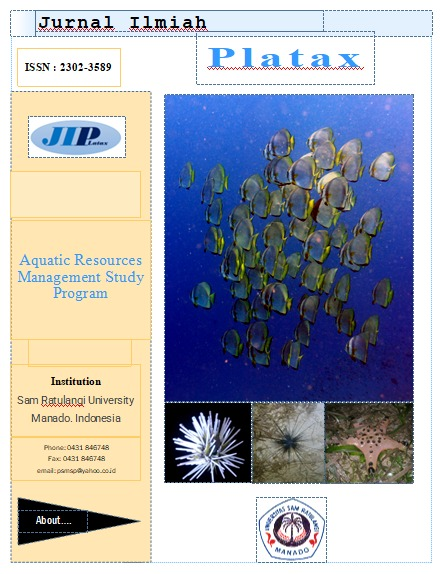Production and productivity of pole and liner catching based at the Fishing Port Ocean in Bitung
Production and productivity of pole and liner catching based at the Fishing Port Ocean in Bitung
DOI:
https://doi.org/10.35800/jip.v11i1.44263Keywords:
Production and Productivity;, Growth Patterns;Abstract
Skipjack tuna is classified as an important pelagic fishery resource and is one of the export commodities so that production needs to be continuously increased by maintaining the sustainability of these fish resources. This study aims to determine the development of production and productivity of the pole and liner vessels observed and to determine the length-weight relationship of the catches of the pole and liner vessels observed at the Bitung Ocean Fishing Port (PPS). In general, the production and productivity of pole and liners based at the Samudera Bitung Fishing Port increased from November 2021 to December 2021 and then decreased again in January 2022, so that they were declared unproductive. Pole and liner catches that are landed at the Bitung Ocean Fishing Port in the period November 2021 - January 2022 tend to get the same results with the size caught, namely 29-64 cm, with a positive allometric growth pattern.
Keywords : Production and Productivity, Growth Patterns, Pole and Liner
Abstrak
Ikan cakalang tergolong sumberdaya perikanan pelagis penting dan merupakan salah satu komoditi ekspor sehingga produksinya perlu terus ditingkatkan dengan menjaga kelestarian sumberdaya ikan tersebut. Penelitian ini bertujuan untuk mengetahui perkembangan produksi dan produktivitas dari kapal pole and liner yang diamati dan mengetahui hubungan panjang-berat hasil tangkapan kapal pole and liner yang diamati di Pelabuhan Perikanan Samudera (PPS) Bitung. Secara umum produksi dan produktivitas pole and liner yang berpangkalan di Pelabuhan Perikanan Samudera Bitung mengalami kenaikan dari bulan November 2021 ke bulan Desember 2021 dan selanjutnya mengalami penurunan kembali pada bulan Januari 2022, sehingga dinyatakan tidak produktif. Hasil tangkapan pole and liner yang didaratakan di Pelabuhan Perikanan Samudera Bitung pada periode November 2021 – Januari 2022 cenderung mendapatkan hasil yang sama dengan ukuran yang tertangkap yaitu 29-64 cm, dengan pola pertumbuhan bersifat alometrik positif.
Kata Kunci : Produksi dan Produktivitas, Pola Pertumbuhan, Pole and Liner
References
Akbar, M.A., Suryanto & Triharyuni, S. 2016. Analisis Perikanan Huhate di Perairan Larantuka, Flores. Jurnal Penelitian Perikanan Indonesia. Vol 22. No 2.
Effendie, M.I. 1997. Biologi Perikanan. Yayasan Pustaka Nusantara. Yogyakarta. 163 hal.
Effendie, M.I. 1979. Metoda Biologi Perikanan.Yayasan Dewi Sri Bogor. 112 hal.
Erna. 1996. Studi Tentang Beberapa Parameter Biologi Populasi Ikan Layang (Decapterus ruselli Ruppel) di Perairan Kabupaten Baru. Skripsi. Fakultas Ilmu Kelautan dan Perikanan Universitas Hasanuddin.
Karman. A, Martasuganda. S , M. Fedi A. Sondita. F.A., Baskoro. M. (2016). Basis Biologi Cakalang Sebagai Landasan Pengelolaan Perikanan Berkelanjutan di Provinsi. Jurnal Ilmu dan Teknologi Kelautan Tropis, Vol. 8, No. 1, Hlm. 159-173.
Usemahu, A. R dan Tomasila, L. A. 2003. Teknik Penangkapan Ikan. DKP Pusat Pendidikan dan Pelatihan Perikanan Ambon.
Downloads
Published
How to Cite
Issue
Section
License
Copyright (c) 2023 Yudistira Josua Mamarimbing, Frangky Erens Kaparang; Ivor Lembondorong Labaro

This work is licensed under a Creative Commons Attribution-NonCommercial 4.0 International License.
COPYRIGHT
Authors who publish with this journal agree to the following terms:
Authors hold their copyright and grant this journal the privilege of first publication, with the work simultaneously licensed under a Creative Commons Attribution License that permits others to impart the work with an acknowledgment of the work's origin and initial publication by this journal.
Authors can enter into separate or additional contractual arrangements for the non-exclusive distribution of the journal's published version of the work (for example, post it to an institutional repository or publish it in a book), with an acknowledgment of its underlying publication in this journal.
Authors are permitted and encouraged to post their work online (for example, in institutional repositories or on their website) as it can lead to productive exchanges, as well as earlier and greater citation of the published work (See The Effect of Open Access).




















